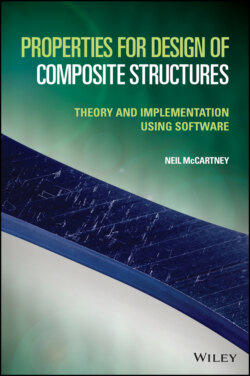Читать книгу Properties for Design of Composite Structures - Neil McCartney - Страница 92
4.11 Comparison of Predictions with Known Results
ОглавлениеOne of the more remarkable aspects of the results derived in this chapter is that Maxwell’s methodology, when applied to two-phase fibre-reinforced composites where the reinforcing cylindrical fibres all have the same size, is that for the case of transverse thermal conductivity, bulk and shear moduli, transverse thermal expansion and transverse thermal conductivity, the effective properties correspond exactly to one of the bounds derived using variational techniques. This bound is also identical to estimates for the properties obtained using the composite cylinders assemblage method. These results are remarkable as one might expect Maxwell’s methodology to be accurate only for sufficiently low volume fractions of reinforcement. The reason for this is that the methodology involves the examination of the stress and displacement fields in the matrix at large distances from the assembly of parallel fibres, and assuming that the perturbing effect of each fibre can be approximated by assuming all fibres are located at the same point. The nature of this approximation is such that one can expect that all interactions between fibres in the cluster are neglected, and that the resulting effective properties will be accurate only for low volume fractions. This appears to contradict the finding that the estimates correspond exactly with one of the variational bounds and with the results arising from the use of the composite cylinders assemblage model. The latter techniques are expected to lead to reasonable estimates of effective composite properties for all volume fractions. It should also be noted from (4.183) that κeff→κf when Vf→1. These facts lead to the conclusion that results derived using Maxwell’s methodology are not restricted to low fibre volume fractions.
The effective properties of a two-phase composite, derived using Maxwell’s methodology, may be expressed in the form of a mixtures estimate plus a correction term, as seen from the results in Section 4.8. It should be noted that the correction term is always proportional to the product VfVm of volume fractions, and a term that involves the square of property differences for the case of conductivity, bulk and shear moduli, and the product of the bulk compressibility difference and expansion coefficient difference for the case of thermal expansion. The form of these results is the preferred common form for the effective properties, having the advantage that the conditions governing whether an extreme value is an upper or lower bound are easily determined.
It is useful now to compare predictions of effective composite properties with those in the literature obtained using numerical methods, and which are expected to be accurate. First, the transverse thermal conductivity is considered and the comparison of Maxwell’s methodology with results of Perrins et al. [8] is shown in Figure 4.2. The normalised effective transverse conductivity is defined by κTeff/κTm and the three materials considered are for isotropic fibres and matrix such that κf/κm=2,10,∞.
Figure 4.2 Comparison of results for normalised effective transverse thermal conductivity obtained using Maxwell’s methodology with those of Modified from Perrins et al. [8] for three different materials.
Figure 4.3 shows a comparison of transverse bulk modulus obtained using Maxwell’s methodology with results of Eischen and Torquato [9]. The normalised effective transverse bulk modulus is defined by kTeff/kTm and the three materials considered are for isotropic fibres and matrix such that μf/μm=135,22.5,6.75, μf/kf=0.75 and μm/km=0.33.
Figure 4.3 Comparison of results for normalised effective transverse bulk modulus obtained using Maxwell’s methodology with those of Modified from Eischen and Torquato [9] for three different materials.
Figure 4.4 shows a comparison of axial shear modulus obtained using Maxwell’s methodology with results of Symm [10]. The normalised effective axial shear modulus is defined by kAeff/kAm and the four materials considered are for isotropic fibres and matrix such that μf/μm=6,20,120,∞.
Figure 4.4 Comparison of results for normalised effective axial shear modulus obtained using Maxwell’s methodology with those of Modified from Symm [10] for four different materials.
Figure 4.5 shows a comparison of transverse shear modulus obtained using Maxwell’s methodology with results of Eischen and Torquato [9]. The normalised effective transverse shear modulus is defined by μteff/μm and the three materials considered are for isotropic fibres and matrix such that μf/μm=135,22.5,6.75, μf/kf=0.75 and μm/km=0.33.
Figure 4.5 Comparison of results for normalised effective transverse shear modulus obtained using Maxwell’s methodology with those of Modified from Eischen and Torquato [9] for three different materials.
